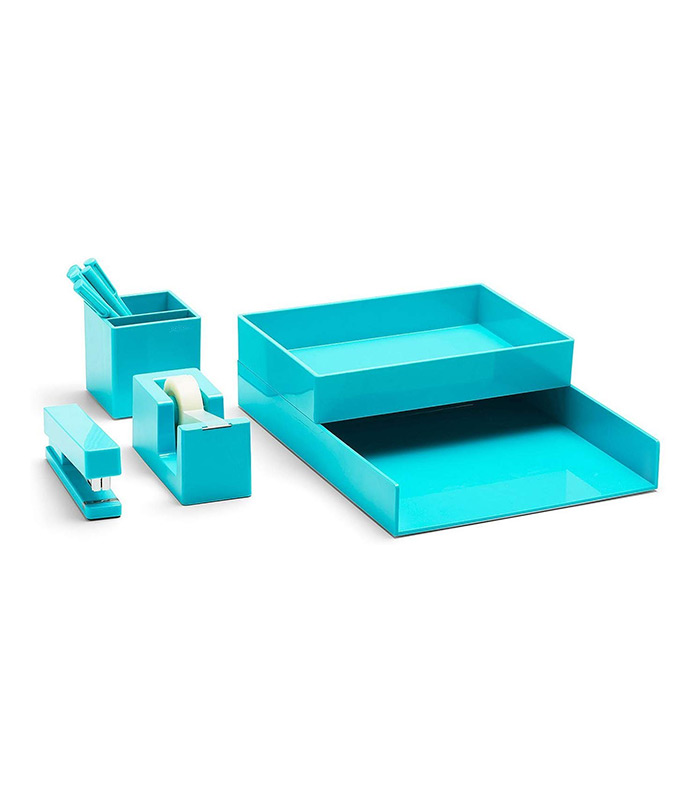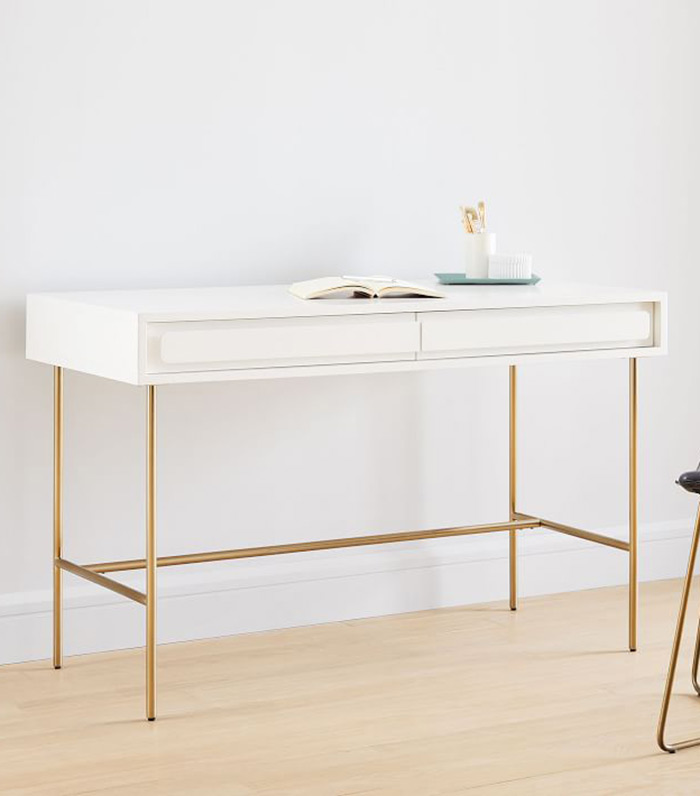7 Changes to Make in Your Office If You Want to Be Better at Your Job
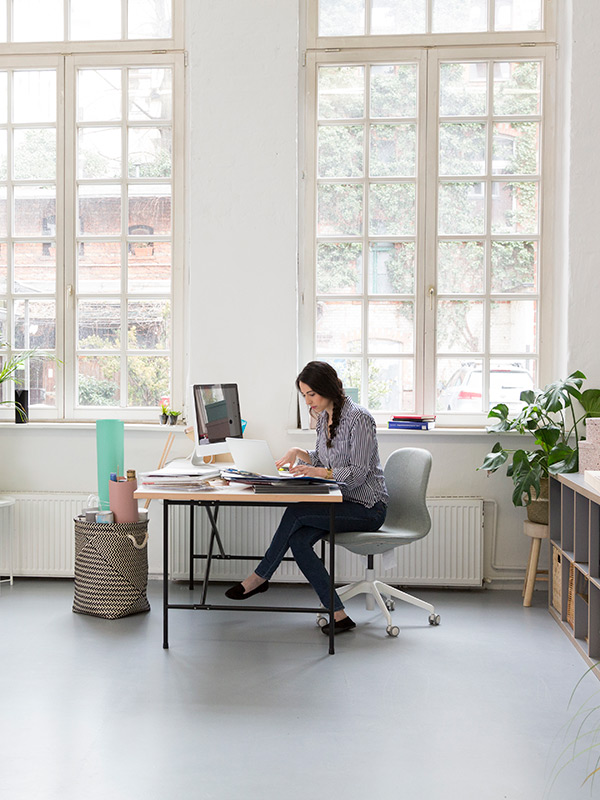
I think it goes without saying that your job can really affect your health. We've written a lot about job burnout (which the World Health Organization classified as an "occupational phenomenon" in May 2019), and how that stress can be a detriment to your health, both physically and mentally. There are ways that you can support and check in with yourself (and do the same for others, too) in order to create balance and not feel so run down by your job—some of that includes taking mindfulness breaks or coming up with a long-term plan to deal with a stressful work environment. While all of that is especially important, your physical work environment can be contributing to your stress and health as well. Yes, your office itself can be adding to the pressure.
When you think about it, it makes sense. You spend the majority of your hours every week sitting at the same desk, next to the same person. If it's not set up right to help you do your best, chances are you won't be productive or happy. If your desk is a mess or your open-floor office plan is so loud and disruptive, you probably are getting a fraction of the work done, which can lead to more stress when it comes to performance reviews and goals. How anyone in The Office got anything done is beyond me—and I'm going to base their success as a top-performing paper branch on TV magic.
Since we're focusing on creating a healthier environment at home and at work for a healthier life, we wanted to find out the ways you can set up your office space for success. Some of it has to do with your desk setup, and some of it has to do with general office etiquette and how you deal with your colleagues.
We reached out to Julie Morgenstern, an organizing and productivity expert and best-selling author of Time to Parent: Organizing Your Life to Bring Out the Best in Your Child and You, and Veronica Gilrane, who leads Google's People Innovation Lab (PiLab), which conducts research to make work better in and outside of Google, for tips on how to set up your office environment so you can be better at your job and feel less stressed. Take a look at what they had to say below.
Create Zones at Your Desk
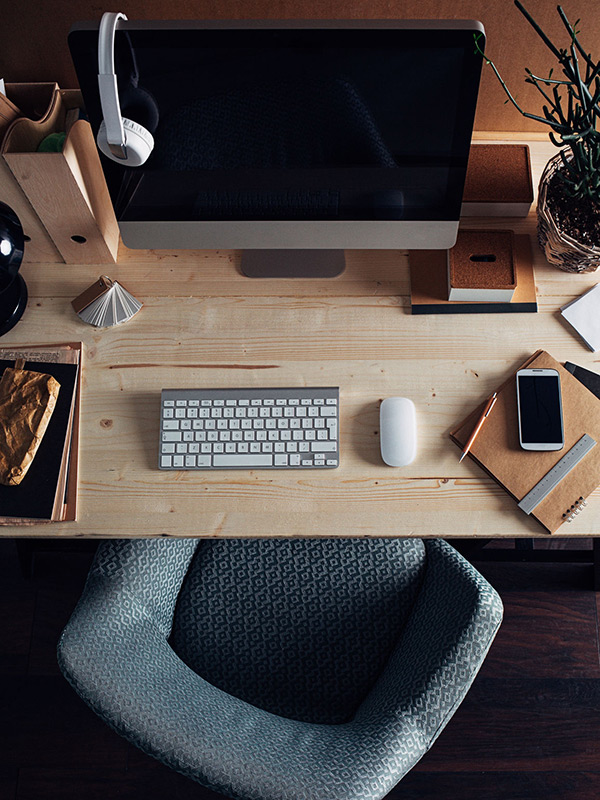
Morgenstern suggests dividing your workspace into "zones," and you can figure out what that means to you by thinking about what you do at your desk and what you need in order to do work. Maybe you need a spot on your desk for all the paper materials you need to reference for a project you're working on, or maybe you have an inbox or an outbox. And, of course, you'll need a zone for your supplies, like pens, a stapler, scissors, etc.—but keep in mind that you might want to keep it bare bones to reduce the clutter on your desk. You don't really need 15 pens in your pencil holder or two staplers.
Keep Your Desk Clear
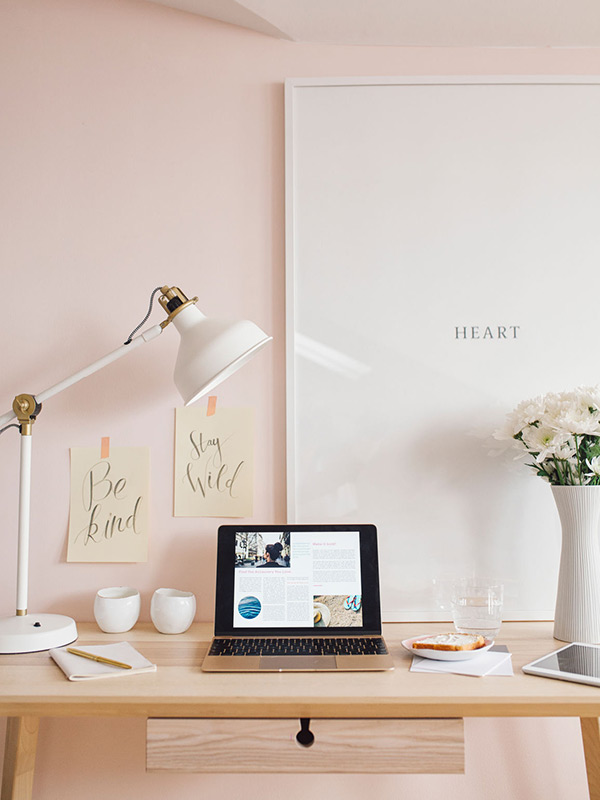
Morgenstern also advises keeping your desk as clear as possible. Clutter can be distracting, and not having an organized space can be a time-suck, too, if you're trying to find that one printout in a pile of hundreds. And filing can be your friend. "Anything you're working on should be in a file, if you can," Morgenstern says. "Not sitting on top of your desk, but in a filing system, in a single drawer where you keep all your active projects if they're on paper. You can have a folder for each project, and then you keep it in a drawer, and then when you're ready to work on it, you take it out, you can spread it all over your desk if you want."
If most of your work is done digitally, the same kind of organization method can be used for your digital files—organize emails into folders or documents into folders on your computer.
Hide Your Phone

If your job doesn't require you to be on your phone at all times, keep it away so you can avoid distractions. Or, if you have a work phone and a personal phone, keep your personal one at arm's length. "Email, instant messaging, social media, and all that stuff are constant, real distractions. You have to recognize that even if they're not visible, they are also part of your work environment. They're like the invisible distractions, but they're there," Morgenstern says.
If you do need a break to look at your personal accounts, she suggests setting specific times that you allow yourself a moment to check your Instagram or other social media accounts.
Sync Up With Your Colleagues

It's important to chat with your colleagues to figure out what their workspace preferences are and vice versa. It can avoid a lot of pent-up resentment and passive-aggressive behavior. This is especially important in open office spaces. Open office plans are pretty much commonplace these days—they're supposed to be creatively stimulating and collaborative, but a recent study found that they have the opposite effect.
"It’s important to set clear team norms for how people get work done in the office. Often these norms are assumed rather than explicitly stated, so it can be helpful to discuss, establish, and document team norms about written and verbal communication in a common space," Gilrane says. "For example, on my team, we meet once a quarter to discuss each of our work preferences and then agree on team norms. While there are some differences in how folks like to get work done and how much quiet time they need, it's helpful to build awareness around work preferences. During periods when a lot of heads-down time is required, using noise-canceling headphones, finding a quiet conference room, or even working from home are all possible solutions."
With some open-office spaces, it can also mean cramped desks—for some, long gone are the days of palatial cubicles. When you're working in close quarters, you'll also want to talk with your neighbor about your daily schedules. Morgenstern suggests working with your seatmate to synchronize schedules for quiet time and more "noisier" times, and agreeing that phone calls during quiet time should be made elsewhere.
Use the Whole Office

A lot of open-offices offer different spaces to work other than your desk. A little change of scenery can help you stay refreshed and energized. Gilrane suggests considering other spaces in your work environment, like cafeterias, break rooms, and outdoor spaces, to get work done or have casual meetings with co-workers.
Morgenstern agrees, adding that this is where an open-office space can be an advantage if you think outside your desk: "The one thing about an organic workspace is your office is much bigger than just a desk, and you have a variety of places to work. If you make the commitment to use all parts of the space for their best use, it can actually be really cool."
Categorize Your Work

Morgenstern says there are three different types of work: staccato (short, quick tasks); legato (work that takes more focus and requires a long uninterrupted block of time); and meetings (well, you know what those are). She suggests thinking about these different tasks and using a method she calls "batching and matching," which is taking the type of work and doing it in a certain spot in the office that is more conducive to it. "Batch your work, so do a bunch of staccato work at the same time. Processing your email, sending out things, doing quick clean-up work—whatever the little interruptible administrative stuff is. You batch that, and then you match it to the environment, which is, Oh, I can do that kind of stuff in the open space because if anybody interrupts me, it's fine. I only need to focus for five or 10 minutes at a time."
For legato work, you can do that at your desk or in a focus room. And for meetings, you can decide if it's formal enough for a conference room, or casual and small for a common space.
Practice Interruption Etiquette

This goes along with syncing up with your colleagues about work preferences. Find out when it's okay to interrupt someone and when it's not, Morgenstern advises. This applies to both work- and social-related interruptions, because sometimes your work wife can't wait to tell you about her date last night, but you have a report you need to send to your boss in an hour and you really don't want to be rude, but you have to get stuff done.
And If You Work From Home
The work-from-home life is becoming even more normal and popular, now that technology has made it even easier to communicate virtually. Recent analysis by Global Workplace Analysis and FlexJobs, a job search site for remote and flexible jobs, found that the number of people telecommuting in the U.S. increased 159% between 2005 and 2017. While working from home sounds nice, it comes with its own sets of challenges, too, so Morgenstern and Gilrane shared their tips for remote workers as well.
Create an Actual Workstation
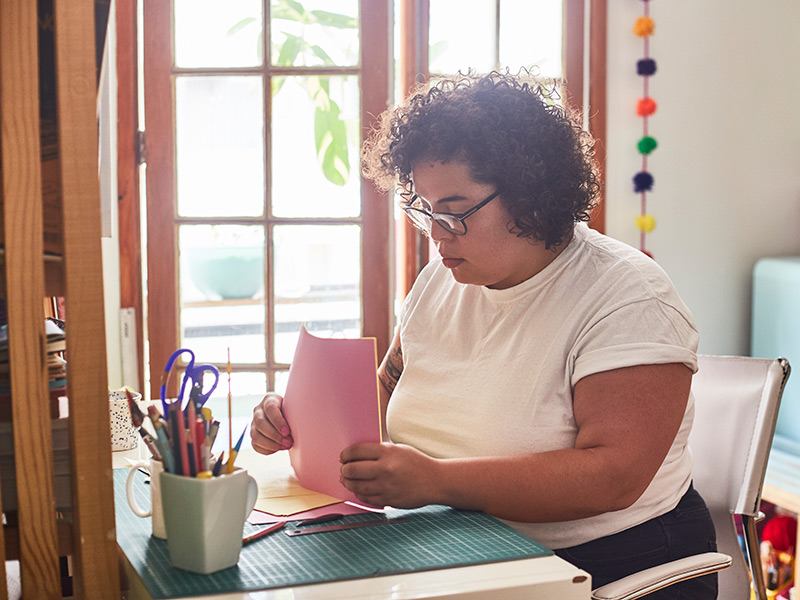
"When you work from home, it's very important to have a designated workstation, and I think a lot of people skip that step," Morgenstern says. "They're like, Hey, I'm on wireless. I can work anywhere. I can work on my kitchen table. I can work in my bedroom. I can work in a living room. I think that is a very big mistake for multiple reasons. Number one, when you have a designated workspace, you can set it up so that everything you need is at your fingertips, and there's like a whole visceral, bunch of triggers that say, This is where I work. This is where I put my work energy on, my work hat on, my work focus on."
And your workspace doesn't have to be a home office or nook; it can just be a desk but just knowing you have a designated space will help you get in the work mindset.
Get Dressed

While working from home in your pajamas can be tempting, and not to mention incredibly easy, it can mess with your productivity. "I think you should get dressed for work, and then you should change your clothes when you 'go back home.' In other words, give yourself other physical signals that tell your body and your mind, 'We're changing gears now,'" Morgenstern suggests.
Leave Your House

When you work from home, it can be easy to get so caught up in your work that you don't stop until long after 5 p.m. To stop yourself from overworking when you don't need to, Morgenstern recommends leaving the house when the workday is over, even if it's just for a walk around the block. "Then when you come back home, you're in your home brain, home mode, home focus," she says.
Amp Up Your Communication Skills
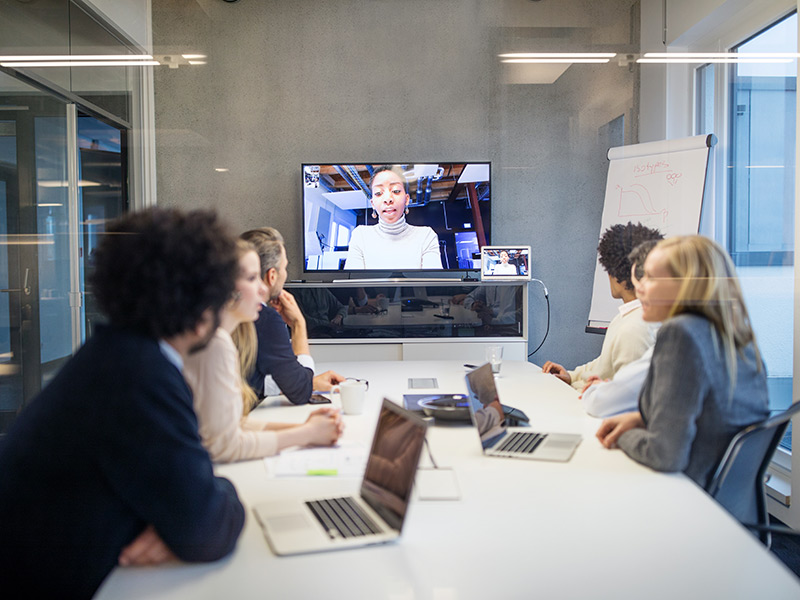
A lot of things can be misconstrued or communication can be strained when you're not working with someone face-to-face, so it's important to stay connected. "PiLab research suggests there are three aspects of connection that matter most: getting connected, being connected, and feeling connected," Gilrane says. "Help empower your team by sharing specifics around logistics and a detailed agenda well in advance of a meeting so you can make the most of your time together. If possible, leverage video conferencing technology when meeting with virtual teammates and ensure you are visually present by zooming in the camera. Finally, help remote workers feel connected by getting to know your virtual teammates on a personal level to build trust. One way to do so is to ask open-ended questions at the start of a meeting ('How was your weekend?') to share details about your life, world, and work."
Next up: Here's How to Look Out for Yourself (and Your Work Wife) in the Office
This article is provided for informational purposes only and is not intended to be used in the place of advice of your physician or other medical professionals. You should always consult with your doctor or healthcare provider first with any health-related questions.
Sarah is lifestyle writer and editor with over 10 years of experience covering health and wellness, interior design, food, beauty, and tech. Born and raised in Los Angeles, she attended New York University and lived in New York for 12 years before returning to L.A. in 2019. In addition to her work atBest Knockoff Luxury Clothing , she held editor roles at Apartment Therapy, Real Simple, House Beautiful, Elle Decor, and The Bump (sister site of The Knot). She has a passion for health and wellness, but she especially loves writing about mental health. Her self-care routine consists of five things: a good workout, “me” time on the regular, an intriguing book/podcast/playlist to unwind after a long day, naps, and decorating her home.
